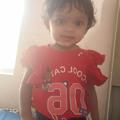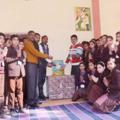Question 1 :
A (6, 1), B (8, 2) and C (9, 4) are three vertices of a parallelogram ABCD. If E is the midpoint of DC, find the area of ∆ ADE.
Question 2 :
The area of a triangle with vertices (a, b + c), (b, c + a) and (c, a + b) is :
Question 3 :
Find the coordinates of a point A, where AB is the diameter of a circle whose centre is $\left(2, – 3\right)$ and B is $\left(1, 4\right)$.
Question 4 :
Find the distance between the following pair of points: (-5,7) , (-1,3).
Question 5 :
Find the area of the triangle formed by the points P $\left(–1.5, 3\right)$, Q $\left(6, –2\right)$ and R $\left(–3, 4\right)$.
Question 6 :
<img style='object-fit:contain' src='https://teachmint.storage.googleapis.com/question_assets/cbse_ncert/61b19bd2273b230584979a22.png ' />
The above image shows the arrangement of desks in a classroom. Ashima, Bharti and Camella are seated at A $\left(3, 1\right)$ , B $\left(6, 4\right)$ and C $\left(8, 6\right)$ respectively. Do you think they are seated in a line?
Question 7 :
Find the coordinates of the points of trisection of the line segment joining $\left(4, -1\right)$ and $\left(-2, -3\right)$.
Question 8 :
The vertices of a ∆ABC are A $\left(4, 6\right)$, B $\left(1, 5\right)$ and C $\left(7, 2\right)$. A line is drawn to intersect sides AB and AC at D and E respectively, such that $\frac{AD}{AB}$=$\frac{AE}{AC}$=$\frac{1}{4}$. Calculate the ratio of the area of the triangle ADE to the area of the triangle ABC.
Question 9 :
Find the area of the triangle whose vertices are $\left(2, 3\right)$, $\left(–1, 0\right)$, $\left(2, – 4\right)$
Question 10 :
Find a relation between x and y such that the point $\left(x, y\right)$ is equidistant from the point $\left(3, 6\right)$ and $\left(– 3, 4\right)$.
Question 11 :
Find the value of ‘k’, for which the points $\left(8, 1\right)$, $\left(k, – 4\right)$ and $\left(2, –5\right)$ are collinear.
Question 12 :
Check whether (5, -2), (6, 4) and (7, -2) are the vertices of an isosceless triangle.
Question 13 :
If A $\left(x_1, y_1\right)$, B $\left(x_2, y_2\right)$ and C $\left(x_3,y_3\right)$ are the vertices of ∆ABC, find the coordinates of the centroid of the triangle.
Question 14 :
The distance of a point from the x-axis is called its y-coordinate, or ordinate. TRUE or FALSE ?
Question 15 :
If A and B are $\left(– 2, – 2\right)$ and $\left(2, – 4\right)$, respectively, find the coordinates of P such that AP = $\frac{3}{7}$ AB and P lies on the line segment AB.
Question 16 :
Are the points $\left(1, 5\right)$, $\left(2, 3\right)$ and $\left(– 2, – 11\right)$ collinear ?
Question 17 :
Points A (–6, 10), B (–4, 6) and C (3, –8) are collinear such that AB = $\frac {2}{9}$AC. State true or false.
Question 18 :
What is the distance between two points P ($x_1,y_1$) and Q ($x_2,y_2$) ?
Question 20 :
ABCD is a rectangle formed by the points A $\left(–1, –1\right)$, B $\left(– 1, 4\right)$, C $\left(5, 4\right)$ and D $\left(5, – 1\right)$. P, Q,R and S are the mid-points of AB, BC, CD and DA respectively. Name the type of quadrilateral.











































